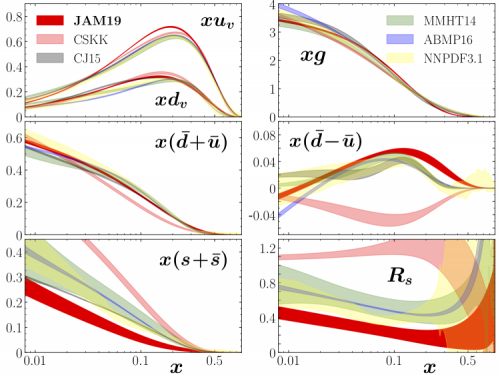The determination of the three-dimensional structure of hadrons in terms of the fundamental quark and gluon (or parton) degrees of freedom of QCD is a central mission of the Jefferson Lab science program. The Theory Center plays a leading role in the development of new formalisms and techniques to quantify this structure through various quantum correlation functions (QCFs), such as parton distribution functions (PDFs), fragmentation functions (FFs), transverse momentum dependent distributions (TMDs), generalized parton distributions (GPDs), and multi-parton correlation functions.
As well as developing the theoretical foundations of the QCF studies through collinear or TMD factorization, a critical part of this program is the extraction of the partonic structures from the experimental data. This is achieved through global QCD analyses, using modern Bayesian inference techniques, in close collaboration with experimental physicists. The Jefferson Lab Angular Momentum (JAM) Collaboration is pioneering a multi-step Monte Carlo approach [1,2] to the analysis of spin-averaged and spin-dependent PDFs, FFs and TMDs (see figure), to reliably sample Bayesian posterior distributions for parameters and produce robust uncertainty quantification, while the CTEQ-Jefferson Lab (CJ) Collaboration [3] utilizes extensive experience with single fit technology to focus in particular on spin-averaged PDFs at large parton momentum fractions, x. An important feature of the JAM analyses is the simultaneous determination of various QCFs which are interdependent in some observables, such as semi-inclusive DIS.

Comparison of the JAM19 Monte Carlo analysis of unpolarized PDFs for various flavors with recent other PDF determinations [1].
Extensions of the global QCD analysis paradigm have recently explored using lattice QCD data as an additional constraint on QCFs, especially in cases where there are limitations on what experimental data can constrain. This has synergies with recent developments in the calculations of the x dependence of QCFs, through the quasi-PDFs, pseudo-PDFs or lattice cross sections approaches [4].
For nuclei, studies have focused on nuclear medium modifications in light nuclei, for which the nuclear wave functions are better determined. The possible role of short-range correlations and nucleon off-shell effects is being examined in phenomenological and theoretical approaches to ascertain their role in the nuclear EMC effect [5].
The JLab Theory Center also plays a leading role in developing the physics case, including detailed impact studies, for next-generation studies of partonic structure with the EIC [6].
[1] N. Sato, C. Andres, J. J. Ethier, W. Melnitchouk, Phys. Rev. D 101, 074020 (2020).
[2] P. C. Barry, N. Sato, W. Melnitchouk and C.-R. Ji, Phys. Rev. Lett. 121, 152001 (2018).
[3] A. Accardi et al., Phys. Lett. B 801, 135143 (2020).
[4] J. Bringewatt, N. Sato, W. Melnitchouk, J. W. Qiu, F. Steffens and M. Constantinou, Phys. Rev. D 103, 016003 (2021).
[5] X. G. Wang, A. W. Thomas and W. Melnitchouk, Phys. Rev. Lett. 125, 262002 (2020).
[6] R. Abdul Khalek et al., arXiv:2103.05419 [physics.ins-det].

